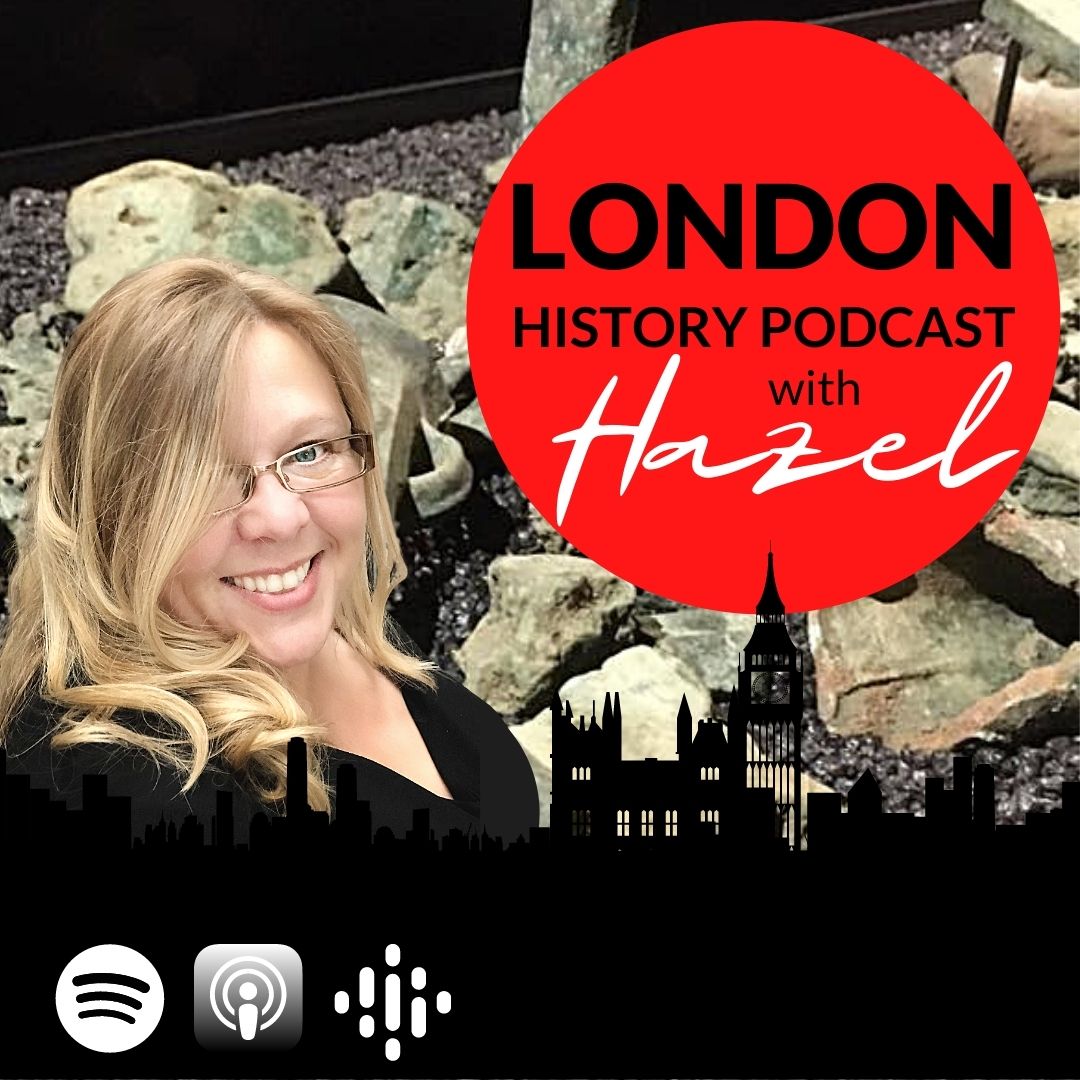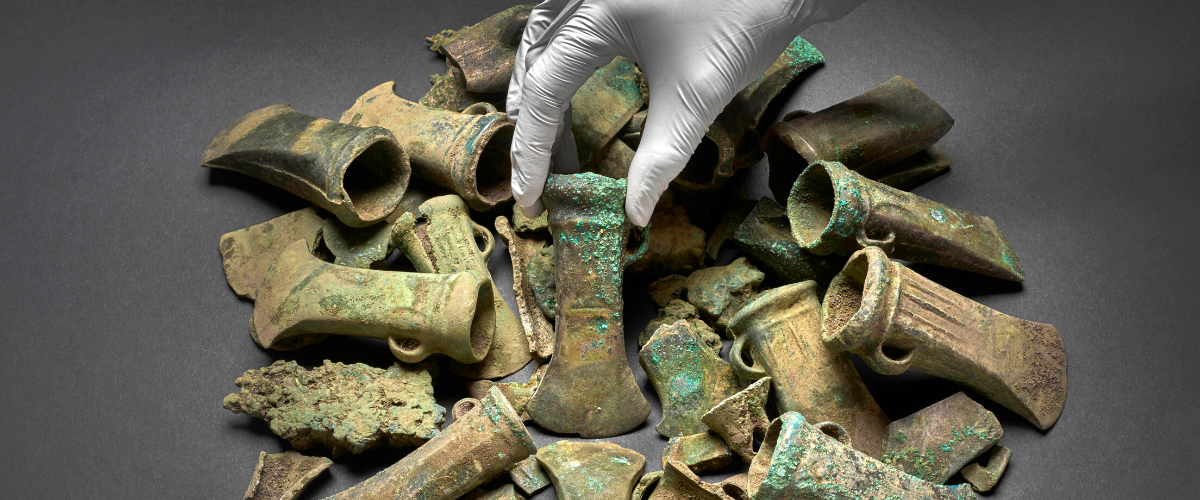Did you know about The Havering Hoard?
Join Hazel Baker and Ian McDiarmid as they give you the full visitor experience review about the Havering Hoard: A Bronze Age Mystery from the Museum of London, Docklands.

London Guided Walks » Episode 22: The Havering Hoard
Did you know about The Havering Hoard?
Join Hazel Baker and Ian McDiarmid as they give you the full visitor experience review about the Havering Hoard: A Bronze Age Mystery from the Museum of London, Docklands.
 Hazel Baker: Hello and welcome to London Guided Walks London History podcast. In the coming episodes, we will be sharing our love and passion for London, its people, places and history in an espresso shot with a splash of personality. For those of you who don’t know me, I am Hazel Baker, founder of London Guided Walks, providing guided walks and private tours to Londoners and visitors alike.
Hazel Baker: Hello and welcome to London Guided Walks London History podcast. In the coming episodes, we will be sharing our love and passion for London, its people, places and history in an espresso shot with a splash of personality. For those of you who don’t know me, I am Hazel Baker, founder of London Guided Walks, providing guided walks and private tours to Londoners and visitors alike.
To accompany this podcast we also have hundreds of London history blog posts for you to enjoy, absolutely free. And we’ve also launched The Daily London, providing you with daily inspiration of things to do in London for Londoners. You can listen on iTunes, Spotify, or even add it to your Alexa flash briefings, or you can check it all out on our website londonguidedwalks.co.uk/flash.
Don’t forget too, that we’re also offering a September sale. You can get 20% off of any private tour booked by the end of this September. You can book it for January, April next year, it doesn’t matter as long as you use the promo code SUMMER2020 and book before the end of the month to get your 20% off.
All right. So we have also Ian McDiarmid in the studio today. He’s is a city of London guide. Hello.
 Ian McDiarmid: Hello.
Ian McDiarmid: Hello.
Hazel Baker: All right. So today we are all about the late bronze age Havering Hoard, which is at the Museum of London, Docklands. We were supposed to be going as a little preview earlier on, but of course COVID changed plans for that.
And so we have visited ourselves today. And so we’re able to give you the full visitor experience review.
Ian McDiarmid: Yeah that’s right. It’s an amazing thing. Isn’t it? The main thing to say about the hoard, I think is probably that it’s the largest bronze age hoard found in the London areas. It’s impressive. Isn’t it?
Hazel Baker: Yeah.
Ian McDiarmid: Anyway, Hazel, you’re slightly better. No, you are better than I am at assimilating information. So I’m going to ask you a series of questions about the exhibition we visited in about the Havering Hoards.
Hazel Baker: Cool, well I’m in. Well, let’s just puts it all into perspective for everybody else. Cause they might not have even heard of the Havering Hoard and it’s in Museum of London, Docklands.
So this is a nearest Canary Wharf West India key rather than Museum of London in the city of London. So by no means, are we bronze age experts at all, but we’re talking from a point of view of knowing a little bit about history, watching lots and lots of time team, and talking about the visitor experience and what we took away from it really.
As Ian said, this is an absolutely free exhibition. We were, it took us about 45 minutes to go around?
Ian McDiarmid: Yeah.
Hazel Baker: And also the Museum of London, Docklands is actually in a warehouse. So, nice to add a little bit of a, you know, historic value. It’s not a brand new building. That’s what I’m saying.
Yeah. While we’re selling the Museum of Docklands exhibition, we much will mention that obviously, if you do go along, you can go around the Museum of Docklands itself.

Hazel Baker: So let’s set the scene then. So in 2018, a late bronze age site, in Wellington, which is inhaled ring, which is East London. It was being excavated by archaeologists. And late on a Friday, two years ago, rums objects were uncovered. 453 pieces, including tools, weapons, and other objects were found in a total of four hoards, weighing in total 45 kilograms, which is just a huge amount.
So, together, making it as Ian has already said, the largest bronze age hoard ever found in London, but it’s also the third largest hoard to be found in the entire country.
Ian McDiarmid: And also we should mention, perhaps it is highly unusual to find four separate hoards forming one hoard. Individual burials, but treated as one.
Hazel Baker: Yeah. So, I have a question for you here.
Ian McDiarmid: Oh, I thought I was going to ask the question.
Hazel Baker: I changed my mind.
Ian McDiarmid: Okay. Go ahead.
Hazel Baker: When was the bronze age?
Ian McDiarmid: Right. Well, according to the exhibition, and I’ve got no reason for doubting this, they dated the British bronze age as 2200-2700BC. Obviously these prehistoric ages are movable feast but that sounds okay.
And they’ve dated this particular hoard from, some of the, I think the main dating evidence was the style of the accents. Is that right? They’ve given it a kind of provisional dating of about 900 to 800 BC.
Hazel Baker: Yeah. And, just to sort of help you phrase that. So the bronze age comes right after the stone age, but before the iron age.
Ian McDiarmid: Right. Hazel, let me start asking you some questions then, because you’re the, you’re the one who’s very good at retaining information. What kinds of objects does the hoard contain?
Hazel Baker: Yes. So there was a variety, but they kind of split it into, five different areas. The biggest area, 42% of these four mini hoards and making the one Havering Hoard, was 42% was tools. Which I thought was quite interesting. I thought they were going to be, you know, really quite extravagant, beautiful pieces, like let’s say the staff hoard. But no, 42% tools. And then closely following that were metalworking materials. And that was at 39%. Ah, down next were weapons at 15% and then fixtures and fittings, 3% and ornamental was a staggering 1% only.
What one might up the fixtures and fittings?
Well, we’ll come on to that, I’m sure!
The bit you haven’t mentioned, and we should have done really is that these four mini hoards making the Havering Hoard were found in a ditch. And this was a square shaped area of land and in that land, in that enclosure, there were also remains of a roundhouse and other structures. So it wasn’t just a bit of metal or four bits of metal hidden in the ground. So, they’re thinking that it’s possible that this is an area either for a settlement all for ritual purposes as well.
Ian McDiarmid: Yeah. I remember them saying that the ditch itself was discovered in the 1960s through aerial photography in the classical way where the ditch was, it’s a sort of square shape ditch. It left a crop mark. And they’re digging it now, I think because they, somebody wants to dig up the gravel.
Hazel Baker: Yeah.
Ian McDiarmid: So they’ve been…
Hazel Baker: For construction.
Ian McDiarmid: Yeah.
Hazel Baker: Yeah. And also what I found interesting is that the, the four hoards, weren’t equal in size. Now, I don’t know about weight. That would have been a good one to ask but there was no one in the exhibition to ask questions.
Ian McDiarmid: Well, no, but they gave you information on the number of options.
Hazel Baker: Yeah. Yeah. So the first hoard is 131. The second hoard is 155. Third hoard was 122. But then the fourth hoard was a baby one only 45 objects.
Ian McDiarmid: Now, Hazel, what can we learn from the hoard?
Hazel Baker: Then far more than a us plant. But what I took away from here was that it was the number of objects that will give us a clue about, not just the people, but also how they worked. Because these weren’t personal items, you know, if any one presenter, ornamental, then these are working items. They were used items, the axes and the swords had bits out of them like they’d been quite well used. So I think you can take a lot from that. And don’t forget also, the Havering area was quite close to the Thames as well. So we’re looking at, trade and travel and thinking about where all these different components are coming from. I think I remember reading, about the copper alloy is from the Alps. You know, and this, this is talking about Marshland in what’s now, East London. And they were able to get all their materials from across the known bronze age world.
Ian McDiarmid: In the exhibition, from memory, they don’t make clear, which may be fair enough, how the foreign material like the copper got there, did they?
Hazel Baker: No, but they do suggest that because of the river, the water was the fastest and easiest and safest way to get around. But I don’t know whether there were copper or merchants just going along in their little boat on these rivers and seeing who wants to buy. I mean how did that all the sort of that happened or was that there were dedicated markets that in springtime you go to your copper ore market? I’ve no idea!
Ian McDiarmid: Mm, they, they put a lot of the fines together with other material from the museum of London to provide context and a bit of the… I think I’m right in saying that the context with partly provided by two craniums, which had rather nasty marks on them.
Hazel Baker: Gosh. Yes. And they said that these marks, these great big holes, one of them was at the front of the head. Both of the craniums had the lower half their jaws missing, but they still had the upper bit of the skull. But they’ve actually survived these injuries and that enabled the bone to regrow?
Ian McDiarmid: Yes, that survived long enough for the healing process to begin is how they put it. Because they were rather nasty holes, wasn’t there? I mentioned that because, I mean, I didn’t make this explicit in the exhibition, but you think that the copper ore you think of trade. Maybe, or at least exchange of goods between the peoples. But the, the fact that they’ve got those two parts of skulls on display indicate that it wasn’t particularly a friendly time necessarily.
Hazel Baker: But they did say about the reputation of the bronze age being a violent age. But of course, if you’re living in your little family unit in the settlement, I mean, how many times are you going to meet foreigners? Or you know, foreigners is in those that you don’t know, and it’s going to be quite… I mean, we’ve had locked down and we’ve got quite excited when we saw the postman, didn’t we?
Ian McDiarmid: I wanted this walking around the exhibition because what they’ve got is rather fantastic photograph. It’s actually of the marshes on the other side of the river today. And it’s kind of been adapted to make it look like bronzy. So they’ve edited out the buildings and it’s quite magical watching it. Wasn’t it? I mean, it’s just a film of raining marshes over a period of hours, it’s actually worth watching.
That made me think of the obvious fact that these people are on the river and you’d have people coming up and down the river. And how are you respond to that? I mean, do you think here comes somebody, probably wanting to, they may have copper on them and that’s great. Or do you get very anxious in case they’re gonna leave a mark in your cranium?
Hazel Baker: Yeah. I mean, you just, you just have no idea. Maybe they had some sort of flags, signals or whatever, but don’t forget there’s this, the settlement had a ditch. So would that have been for protective purposes?
Ian McDiarmid: Yeah. You were talking earlier about the numbers in each of the hoards. What kind of objects do these hoards consist of?
Hazel Baker: Yeah. So, the socketed act heads, which I was surprised to find came from South Wales. So this, I suppose as linking up with how connected the bronze age world was, the cops tongs hoard, that was quite big. There were spearheads, rings, and these are the finest examples that have been found in the UK.
There has been comparable ones found in France, but they were rather proud of their terat rings. Alright. Yeah. So this isn’t bling that well, it is, but for the horses, so they believe its these circular rings to put on the rains, to stop the rains, getting tangled up when the hoard is tallied with a cart, which kind of then gives the indication that may be caught.
So used as well. It’s not just boats and people on foot. There was a very nice jet bracelet. I have my eye on that one and that’s from wit being in Yorkshire, and the gold bracelet, was either from Ireland or Wales. And then also the were bronze ingots. So these are bits of bronze that have been sort of like missed the mould and, and then they’ve put those in the hoard as well. So they aren’t all completed pieces.
Ian McDiarmid: And I was saying earlier about this, this photograph of raining marshes and how I found that rather magical. What did the Thames look like at the time that this hoard was buried?
Hazel Baker: Well, I spent 13 minutes looking at this video of the light over raining marshes. That’s how long the video was. And as you said, it was quite, quite magical, hypnotic. Don’t forget, we’re talking about a time that is 3000 years ago. And we talk about, you know, the Thames and the embankment with the Victorians building, the embankment in where is London now. But the Thames even then was, far considerably wider than we could imagine.
The riverbanks were all marshlands really quite flat. And also they had lots of plant life, some animals, and birds. But it would have been quite nice. You would’ve been on your own.
Ian McDiarmid: Hmm. Why was the hoard parrot? They advanced four theories, don’t they? As to why it might’ve been there?
Hazel Baker: Yeah. Well shall I mention the four theories and then we can just sort of brush them out?
Ian McDiarmid: Yeah.
Hazel Baker: Alright. So theory one is that, because this is a late bronze age hoard, the theory is that bronze is losing its value, iron was the new favourite, and that bronze was no longer needed and therefore buried in a ditch out of sight out of mind, not needed.
The second one was a sign of power and status. So the big wig, the local big wig was controlling who had access to it. And that would also control the price.
The third one was that, bronze was just kept there for safe keeping and that metal workers, are believed to have been moving around the country, selling their wares, plying their trade, and that with bronze being heavy, they needed somewhere to hide it, until they needed it again.
And then the fourth one was that the hoard, was an offering to the gods. Because when you have a look at how the settlement is laid out, the entrance to the settlement is at the East ie when the sun is rising. And then also when you have a look at where these four pots of hordes were found, they are actually buried in line with the way that the sun moves, which I thought was actually rather clever. And of course that was a big thing for bronze aged times.
So they’re the four theories. Number one, looking at bronze, losing its family. What do you think on that one?
Ian McDiarmid: Well this is the one I don’t like. Partly because it’s contradicted by the other three, which are based on the value of the bonds being valued. And this is just saying that it probably was suddenly superseded. And this is one of the problems with all these INH stone age, bronze age periods is that they’re all very vague and the changes weren’t sudden. And bronze could well have been used alongside on for a long time. So…
Hazel Baker: Well, especially when you’ve got limited resources.
Ian McDiarmid: Yeah. Yeah. And then the other three, well, number two, which is the one about, it’s a sign of power and status and somebody’s trying to control the bronze supply. Well, yeah, it could have been, but there’s no evidence and this is one of the… As an outsider, this is one of the frustrations for me with archaeology is that they can just state any theory they like, and because there’s no evidence, they can’t be wrong.
Hazel Baker: Yeah. Well, don’t forget. That was only two years ago that they found this stuff. Yeah. So they’ve got plenty of time to start putting things together and they haven’t finished excavating the rest of the settlement site. Yeah, exactly.
Ian McDiarmid: But numbers three and four are the ones that I like, and I think, which are that they were possibly for recycling. But the one that I, it seems to be more plausible with the care that was put in, in the value of these objects is some still with ritual. So what do you think, Hazel, what’s your favourite?
Hazel Baker: I’m veering towards the ritual because of the importance of the sun. And also as you said, the way that they were carefully laid. They reckon it took two people, one standing up and pass in the objects to the, the one who had dug the hole and they were in the hole as they were placing carefully placing these items. So this isn’t just a, stuff it all in a bag and cover it up because we’re going to be back in a year to reclaim it. These were purposefully put down in a particular order on a particular fashion. So I’m going for four.
Ian McDiarmid: Okay. Four being that it’s a ritual offering. Yeah.
Hazel Baker: Yeah. I think so.
Ian McDiarmid: Yeah. Okay. I’ll run with that as well.
Hazel Baker: So yeah, so it was a, it was a, a worthwhile trip. And, let us know if you go, tag us in the photos on Twitter or Instagram, and it’d be lovely to hear your thoughts as well.
Ian McDiarmid: Yeah, good. Yeah. I thought it was truly spectacular.
Hazel Baker: Yeah. And for free.
Ian McDiarmid: Yeah. Yeah. Not bad.
Hazel Baker: Not bad at all.